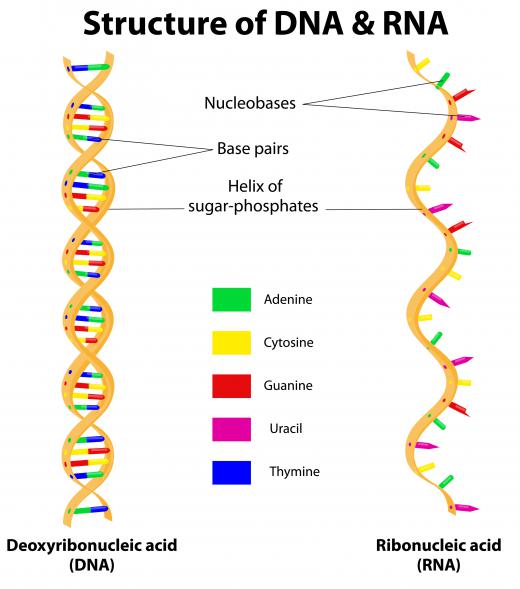What Is a Biomolecule?
The term "biomolecule" refers to a broad category of molecules encompassing all substances produced by an organism's biological processes. These molecules include things such as nucleic acids, proteins, and saccharides. Biomolecules form the bodies of all living beings and are the causes and products of the chemical processes that keep them alive.
A huge number of diverse biomolecules exist, ranging from small molecules of a few atoms to huge, complex structures called macromolecules that can contain thousands or even millions of atoms. Some types of biomolecules are extremely large by molecular standards. This is made possible by one of the properties of carbon, the element on which all known life is based. Carbon atoms can link together in long repeating chains, with other atoms or groups of atoms attached to the chain, to form extremely long molecules called polymers. These polymers can be composed of hundreds of individual structural units chained together and can also split into multiple branches or chemically bonded to other polymer chains to form huge structures.

One of the most common and important type of biomolecules is called a protein, a group of macromolecules essential to biological processes in all forms of life. They are made of chains of smaller biomolecules called amino acids. Different types of proteins serve different functions, such as carrying chemical messages from cell to cell, forming structures that hold cells together, and catalyzing the chemical reactions that drive the organism's metabolism through specialized proteins called enzymes.
Another group of biomolecules are called lipids, a category encompassing substances such as sterols, natural waxes, and glycerides, the best known of which are called fats. Lipids are generally smaller than proteins, though they can still contain polymer chains dozens of carbon atoms in length. Lipids are important to maintaining the structure of cells, because much of each cell's cellular membrane is made of them, and they are also a form of energy storage.
Saccharides, also called carbohydrates, are a type of biomolecule containing only carbon, hydrogen, and oxygen. Two groups of saccharides, called monosaccharides and disaccharides, are commonly referred to as sugars. Saccharide molecules are another important group of substances for energy, are involved in many metabolic processes, and are used as structural supports for some organisms, most notably in the form of cellulose in plants.
Nucleotides are a class of biomolecules made from saccharides bonded to a phosphate group and one of several possible types of nucleobase, a type of nitrogen-based biomolecule. The resulting compounds include molecules called cofactors that help proteins catalyze metabolic chemical reactions and important cellular signaling molecules. Nucleotides are also the primary components of ribonucleic acid (RNA) and deoxyribonucleic acid (DNA), making them one of the most fundamental building blocks of life. The genetic information of living beings is encoded in the arrangement of different types of nucleobases on the long nucleotide chains that make up DNA and govern its activities, making nucleotides the basis of heredity.
Not all organisms can produce every type of biomolecule they need by themselves. Organisms that can synthesize the biomolecules they need from nonliving matter in the environment, such as plants, algae, and some forms of bacteria, are called autotrophs. Organisms that cannot do this by themselves, called heterotrophs, are dependent on a combination of molecules synthesized in their own bodies and other biomolecules ingested by eating other organisms that contain substances the heterotroph does not produce itself. This category includes animals, fungi, and some single-celled organisms.
AS FEATURED ON:
AS FEATURED ON:











Discuss this Article
Post your comments